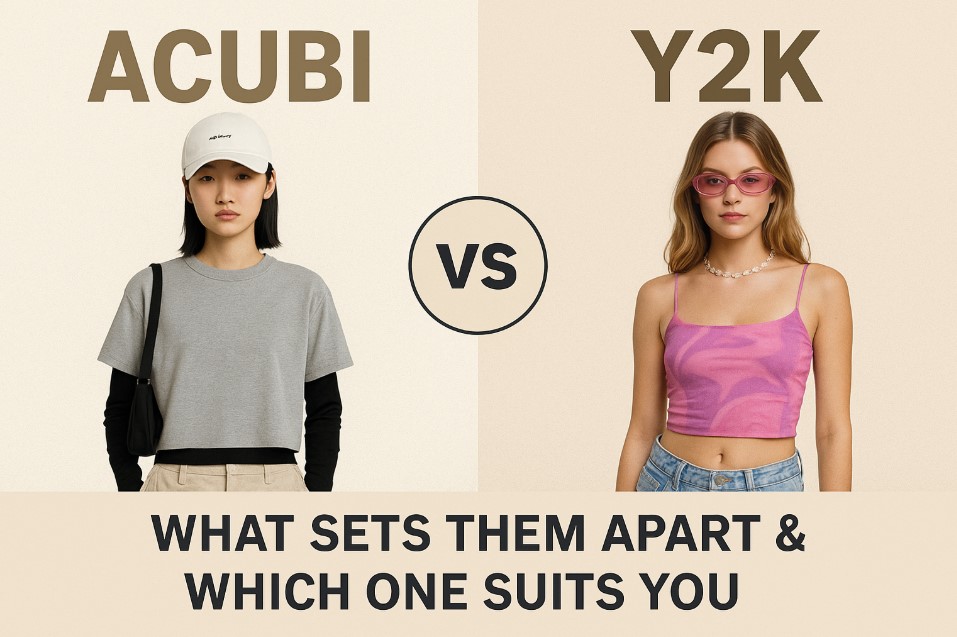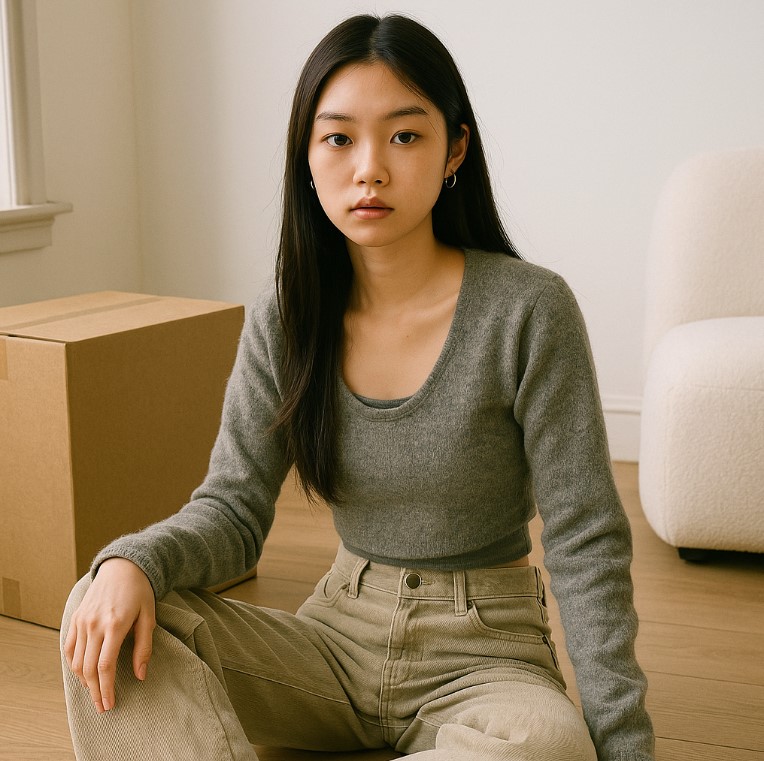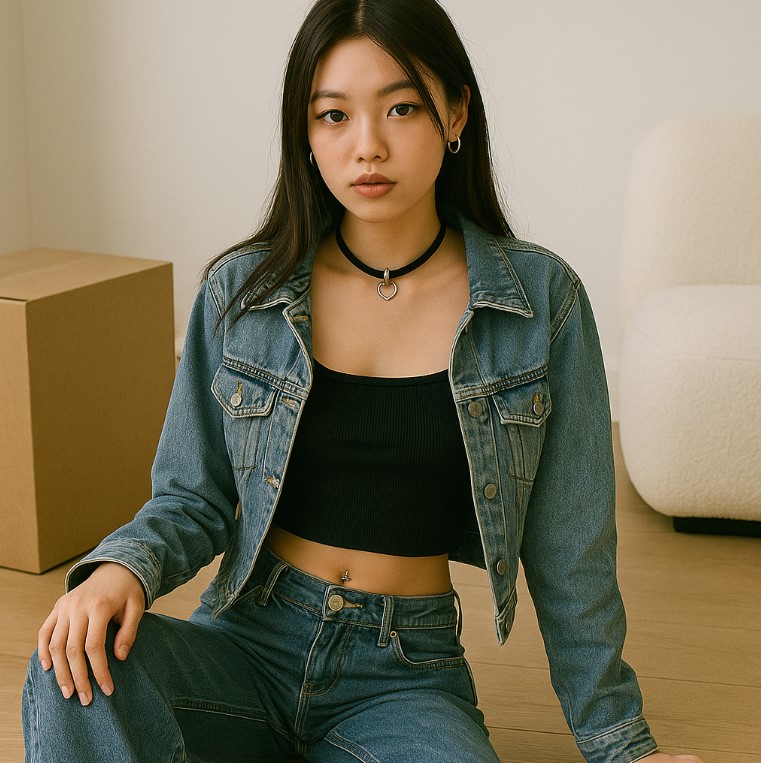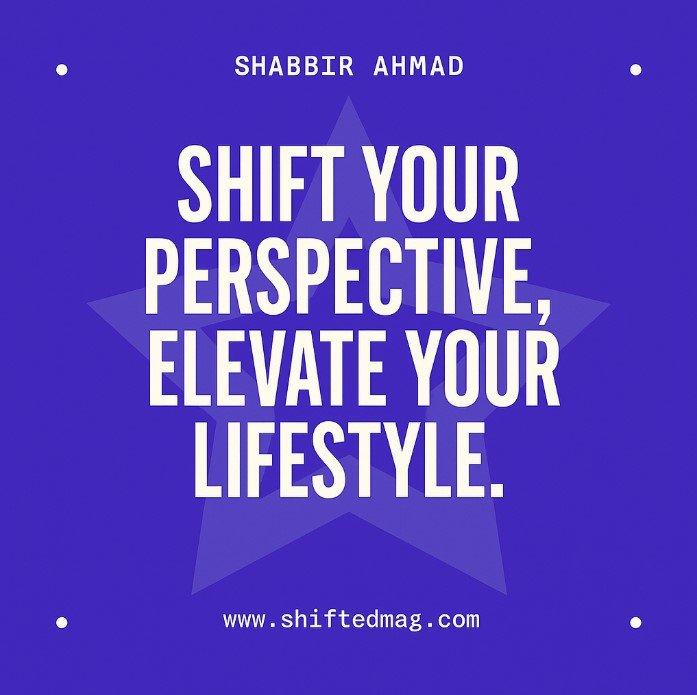Fashion
Acubi vs Y2K: What Sets Them Apart & Which One Suits You

Fashion is full of cycles, trends, and micro-aesthetics that capture the imagination of people across the world. Two styles that have gained particular attention in recent years are Acubi and Y2K. While they share certain roots in minimalism, nostalgia, and youthful expression, they also have many differences. For those trying to understand where these two aesthetics overlap and where they diverge, it is helpful to look at their origins, key features, and cultural appeal. This article explores both styles in detail and provides a guide for deciding which one may suit you best.
The Origins of Acubi
Acubi style is a relatively new fashion aesthetic that rose to prominence in online spaces, particularly within Korean and East Asian fashion communities. The term is often connected with understated, neutral tones, layering, and subversive basics. Unlike styles that seek boldness or heavy accessorizing, Acubi embraces quiet confidence. It is influenced by both minimalist fashion and elements of cyber or grunge styling. The aesthetic is built on the idea that simplicity can stand out in its own right when paired with careful details such as unique cuts, textures, or subtle accessories.

Social media platforms, especially Instagram and TikTok, have played a large role in spreading Acubi looks globally. Many creators show capsule wardrobe combinations, everyday casual outfits, and layering techniques that highlight how versatile the aesthetic can be. It appeals strongly to those who want their clothing to feel modern but not overly polished.
The Roots of Y2K
Y2K fashion refers to the style trends from the late 1990s and early 2000s, a period that coincided with the rise of the internet, pop culture icons, and a unique mix of optimism and futurism. This style is recognized by bold colors, metallic fabrics, crop tops, denim-on-denim, baby tees, and statement accessories like chunky sunglasses and rhinestones. Brands such as Juicy Couture, Von Dutch, and early-era Dior shaped the mainstream understanding of Y2K looks. Celebrities like Britney Spears, Paris Hilton, and Destiny’s Child were central figures who defined the aesthetic for a generation.

In recent years, the revival of Y2K fashion has come through vintage shopping, second-hand markets, and social media-driven trends. Younger audiences who did not experience the early 2000s firsthand are embracing the look, while older fans find it nostalgic. Y2K is often more playful and experimental compared to Acubi, celebrating maximalism rather than restraint.
Key Characteristics of Acubi
To understand Acubi more clearly, it is helpful to break down its defining features. These include:
- Neutral colors: Black, gray, beige, and muted shades dominate. Bright or neon colors are rarely seen.
- Layering: Outfits often combine multiple thin layers, such as long sleeves under short sleeves or vests over shirts.
- Minimal patterns: Patterns are uncommon; most pieces are solid-colored.
- Relaxed fit: Comfort is important, with looser silhouettes that avoid extremes.
- Functional accessories: Bags, hats, and shoes are understated and practical, matching the overall muted palette.
- Cyber-grunge influence: Some outfits incorporate elements of digital-inspired fashion, with hints of futuristic or edgy designs.
Acubi outfits often look effortless but are carefully curated. The appeal lies in looking fashionable without appearing as though too much effort was put into styling.
Key Characteristics of Y2K
Y2K, on the other hand, is defined by its boldness and experimentation. The following features are common:
- Bright colors and shine: Metallics, shiny fabrics, and vibrant hues are common.
- Playful accessories: Butterfly clips, oversized sunglasses, and rhinestone embellishments are iconic.
- Low-rise jeans: Perhaps the most recognizable item from Y2K fashion, often paired with crop tops.
- Brand-heavy looks: Logos and statement pieces were popular, making the outfits instantly recognizable.
- Tech-inspired details: Outfits sometimes included futuristic cuts or materials that reflected the optimism of early internet culture.
- Body-hugging silhouettes: Clothes often emphasized form-fitting styles, balancing playfulness with sex appeal.
The Y2K look is outgoing and confident, attracting those who want to stand out and enjoy attention.
Cultural Influence and Popularity
Both Acubi and Y2K gained popularity because of their strong ties to online culture. Y2K made its comeback thanks to nostalgia-driven trends, while Acubi is a product of newer internet communities and the shift toward minimalist lifestyles. Each style reflects broader cultural ideas: Y2K symbolizes early digital optimism and flashy consumer culture, while Acubi symbolizes modern digital subcultures, restraint, and sustainability through versatile wardrobes.
Interestingly, both styles have communities built around them. Y2K has been revived on resale platforms, through thrifting, and through celebrity influence. Acubi, by contrast, thrives on smaller creators who post styling inspiration for everyday wear. This difference in cultural momentum shows that while Y2K celebrates the past, Acubi creates a pathway for the present and future.
Practicality and Everyday Wear
When deciding which style suits you best, it is important to consider how practical each one feels in daily life. Acubi outfits are more understated and work well in both casual and semi-professional environments. Neutral colors make them easy to mix and match, and layering adds comfort for different weather conditions. Y2K, however, is more expressive and may not always fit in professional or conservative settings. Its boldness, however, makes it ideal for parties, social outings, and events where making a statement is encouraged.
The ease of maintaining a wardrobe also differs. Acubi often requires fewer pieces, with a focus on staples that can be worn in many combinations. Y2K may involve collecting more unique items that are not always interchangeable. Those who want a capsule wardrobe may find Acubi better suited, while those who enjoy variety and experimentation may prefer Y2K.
The Role of Online Communities
The spread of both aesthetics is inseparable from the internet. TikTok and Instagram have popularized outfit inspiration for each style, but the tone differs. Acubi content often focuses on calm, muted visuals and tutorials on layering or building simple wardrobes. Y2K content is more colorful, playful, and heavily tied to music and pop culture references. Online communities also give rise to variations. For example, dti acubi, a term that appears in fashion and digital spaces, merges aspects of Acubi styling with creative online expression, showing how flexible and evolving the aesthetic has become.
Which Style Suits Different Personalities
One of the best ways to decide between Acubi and Y2K is to consider personal taste, comfort, and personality. Each style speaks to a different type of wearer. Acubi is often the choice of people who prefer subtlety, versatility, and quiet confidence. They enjoy clean lines, muted palettes, and the ability to wear the same pieces in many combinations. This style is also attractive for those who value practicality and comfort but still want to look stylish.

Y2K, on the other hand, appeals to individuals who are playful, expressive, and nostalgic. People who love experimenting with bold looks, mixing unexpected colors, and showing off unique statement pieces are more likely to enjoy Y2K. Those who want to capture attention in social settings, express creativity through fashion, or relive the fun of early 2000s trends often find this style most rewarding.
In short, Acubi suits the minimalist who wants a modern, functional wardrobe, while Y2K is perfect for the extrovert who enjoys vibrant expression.
Styling Tips for Acubi
If you want to try Acubi fashion for yourself, it helps to keep a few guidelines in mind. The goal is to create a minimalist yet layered look that feels both stylish and effortless. Useful tips include:
- Focus on neutral colors like black, white, gray, and beige for your wardrobe base.
- Invest in versatile pieces such as plain long-sleeve tops, vests, loose trousers, and oversized shirts.
- Experiment with layering, for example, wearing a fitted shirt under a baggy t-shirt or adding a cropped jacket over a plain dress.
- Choose simple, functional accessories like a black crossbody bag or a baseball cap.
- Keep patterns to a minimum, favoring solid colors for easier mixing and matching.
This style rewards consistency. A small but versatile wardrobe can create many different combinations without requiring endless shopping.
Styling Tips for Y2K
Y2K fashion is characterized by boldness and experimentation, making the rules more flexible. However, some core styling tips can help capture the essence of this aesthetic:
- Look for low-rise jeans, cargo pants, and denim skirts as foundational bottoms.
- Pair them with crop tops, baby tees, or halter necks for an authentic look.
- Add colorful accessories such as butterfly clips, tinted sunglasses, and rhinestone belts.
- Metallic fabrics and shiny textures work well for tops and jackets.
- Sneakers with bold logos or chunky heels can complete the outfit.
The fun of Y2K is in its variety. Unlike Acubi, Y2K thrives on mixing elements and trying out bold combinations.
Side-by-Side Comparison
To highlight the differences between Acubi and Y2K, the following table provides a clear summary:
| Feature | Acubi | Y2K |
| Color palette | Neutral and muted tones | Bright, metallic, and vibrant |
| Fit and silhouette | Relaxed, loose, layered | Form-fitting, bold, playful |
| Accessories | Minimal, functional | Flashy, statement-making |
| Inspiration | Minimalism, cyber-grunge | Pop culture, early 2000s icons |
| Practicality | Easy to wear daily | Best for social or party looks |
| Wardrobe size | Capsule, versatile pieces | Wide variety, less interchangeable |
This comparison shows that while both styles are popular, they differ strongly in philosophy and execution.
The Modern Appeal of Acubi and Y2K
The popularity of both aesthetics reflects wider trends in fashion. Y2K’s revival demonstrates how nostalgia and pop culture continue to influence clothing choices. People want to relive or reinterpret a period filled with optimism and early digital culture. Acubi, however, reflects a newer wave of fashion where minimalism, practicality, and online influence converge. It is particularly attractive to younger people who are navigating limited budgets but still want a polished and stylish wardrobe.
Both styles also represent globalized fashion. Y2K has roots in Western pop culture, while Acubi grew in East Asian communities before spreading worldwide. Their popularity highlights how the internet has broken down barriers and allowed niche aesthetics to reach mass audiences.
Which One Should You Choose?
Choosing between Acubi and Y2K ultimately comes down to lifestyle and preference. Ask yourself the following questions:
- Do you want a wardrobe that is easy to mix and match for everyday life? Acubi might be your best fit.
- Do you want bold outfits that capture attention and feel nostalgic? Y2K is likely the better choice.
- Do you prefer muted, neutral tones, or do you enjoy bright and shiny colors?
- Do you need your outfits to work in professional or school settings, or are you dressing mostly for leisure and social events?
There is no right or wrong answer. Some people even combine elements from both, such as pairing a neutral Acubi base with one or two bold Y2K accessories. Fashion is flexible, and mixing styles is part of the fun.
Final Thoughts
Acubi and Y2K are two aesthetics that reflect very different philosophies. Acubi prioritizes simplicity, function, and subtle appeal. Y2K thrives on boldness, nostalgia, and playful experimentation. Both have carved out loyal communities online and offline, and both continue to influence how people express themselves through clothing.
For those who want a minimalist yet stylish everyday wardrobe, Acubi is an ideal option. For those who enjoy bold expression and reliving or reinterpreting early 2000s culture, Y2K is the clear choice. By understanding the differences, you can select the aesthetic that matches your personality and lifestyle best—or even blend them to create a style uniquely your own.
-

 Social Media2 months ago
Social Media2 months agoWhat the “67” TikTok Meme Really Means
-

 Tech2 months ago
Tech2 months agoWhat To Do When Your Business Faces Network Vulnerabilities
-

 Self Improvement2 months ago
Self Improvement2 months agoUsing BCBS Rehab to Access Quality Addiction Care
-

 Games2 months ago
Games2 months agoPusoy Strategies for Play That Also Work in Pusoy Dos in English






